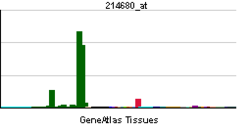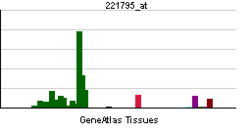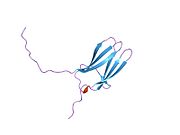- TrkB receptor
-
TrkB receptor also known as TrkB tyrosine kinase or BDNF/NT-3 growth factors receptor or neurotrophic tyrosine kinase, receptor, type 2 is a protein that in humans is encoded by the NTRK2 gene.[1]
Contents
Function
TrkB is the high affinity catalytic receptor for several "neurotrophins", which are small protein growth factors that induce the survival and differentiation of distinct cell populations. The neurotrophins that activate TrkB are: BDNF (Brain Derived Neurotrophic Factor), NT-4 (neurotrophin-4), and NT-3 (neurotrophin-3). As such, TrkB mediates the multiple effects of these neurotrophic factors, which includes neuronal differentiation and survival.
The TrkB receptor is part of the large family of receptor tyrosine kinases. A "tyrosine kinase" is an enzyme which is capable of adding a phosphate group to certain tyrosines on target proteins, or "substrates". A receptor tyrosine kinase is a "tyrosine kinase" which is located at the cellular membrane, and is activated by binding of a ligand to the receptor's extracellular domain. Other examples of tyrosine kinase receptors include the insulin receptor, the IGF1 receptor, the MuSK protein receptor, the Vascular Endothelial Growth Factor (or VEGF) receptor, etc.
Currently, there are three TrkB isoforms in the mammalian CNS. The full-length isoform (TK+) is a typical tyrosine kinase receptor, and transduces the BDNF signal via Ras-ERK, PI3K, and PLCγ. In contrast, two truncated isoforms (TK-: T1 and T2) possess the same extracellular domain, transmembrane domain, and first 12 intracellular amino acid sequences as TK+. However, the C-terminal sequences are the isoform-specific (11 and 9 amino acids, respectively). T1 has the original signaling cascade that is involved in the regulation of cell morphology and calcium influx.
Family Members
TrkB is part of a sub-family of protein kinases which includes TrkA and TrkC. Also, there are other neurotrophic factors structurally related to BDNF: NGF (for Nerve Growth Factor), NT-3 (for Neurotrophin-3) and NT-4 (for Neurotrophin-4). While TrkB mediates the effects of BDNF, NT-4 and NT-3, TrkA is bound and thereby activated only by NGF. Further, TrkC binds and is activated by NT-3.
TrkB binds BDNF and NT-4 more strongly than it binds NT-3. TrkC binds NT-3 more strongly than TrkB does.
The LNGFR
There is one other BDNF receptor besides TrkB, called the "LNGFR" (for "low affinity nerve growth factor receptor"). As opposed to TrkB, the LNGFR plays a somewhat less clear role in BDNF biology. Some researchers have shown the LNGFR binds and serves as a "sink" for neurotrophins. Cells which express both the LNGFR and the Trk receptors might therefore have a greater activity - since they have a higher "microconcentration" of the neurotrophin. It has also been shown, however, that the LNGFR may signal a cell to die via apoptosis - so therefore cells expressing the LNGFR in the absence of Trk receptors may die rather than live in the presence of a neurotrophin.
Interactions
TrkB has been shown to interact with:
- Brain-derived neurotrophic factor,[2][3]
- FYN,[4]
- NCK2,[5]
- PLCG1,[5][6]
- Sequestosome 1,[7] and
- SHC3.[5][8]
Ligands
Agonists
- BDNF
- N-Acetylserotonin
- Amitriptyline
- 7,8-dihydroxyflavone
- 4′-Dimethylamino-7,8-dihydroxyflavone[9]
Further reading
- Klein R, Conway D, Parada LF, Barbacid M (May 1990). "The trkB tyrosine protein kinase gene codes for a second neurogenic receptor that lacks the catalytic kinase domain". Cell 61 (4): 647–56. doi:10.1016/0092-8674(90)90476-U. PMID 2160854.
- Squinto SP, Stitt TN, Aldrich TH, Davis S, Bianco SM, Radziejewski C, Glass DJ, Masiakowski P, Furth ME, Valenzuela DM (May 1991). "trkB encodes a functional receptor for brain-derived neurotrophic factor and neurotrophin-3 but not nerve growth factor". Cell 65 (5): 885–93. doi:10.1016/0092-8674(91)90395-F. PMID 1710174.
- Rose CR, Blum R, Pichler B, Lepier A, Kafitz KW, Konnerth A (November 2003). "Truncated TrkB-T1 mediates neurotrophin-evoked calcium signalling in glia cells". Nature 426 (6962): 74–8. doi:10.1038/nature01983. PMID 14603320.
- Ohira K, Kumanogoh H, Sahara Y, Homma KJ, Hirai H, Nakamura S, Hayashi M (February 2005). "A truncated tropomyosin-related kinase B receptor, T1, regulates glial cell morphology via Rho GDP dissociation inhibitor 1". J. Neurosci. 25 (6): 1343–53. doi:10.1523/JNEUROSCI.4436-04.2005. PMID 15703388.
- Yamada K, Nabeshima T (2004). "Brain-derived neurotrophic factor/TrkB signaling in memory processes.". J. Pharmacol. Sci. 91 (4): 267–70. doi:10.1254/jphs.91.267. PMID 12719654.
- Soppet D, Escandon E, Maragos J, et al. (1991). "The neurotrophic factors brain-derived neurotrophic factor and neurotrophin-3 are ligands for the trkB tyrosine kinase receptor.". Cell 65 (5): 895–903. doi:10.1016/0092-8674(91)90396-G. PMID 1645620.
- Squinto SP, Stitt TN, Aldrich TH, et al. (1991). "trkB encodes a functional receptor for brain-derived neurotrophic factor and neurotrophin-3 but not nerve growth factor.". Cell 65 (5): 885–93. doi:10.1016/0092-8674(91)90395-F. PMID 1710174.
- Haniu M, Talvenheimo J, Le J, et al. (1995). "Extracellular domain of neurotrophin receptor trkB: disulfide structure, N-glycosylation sites, and ligand binding.". Arch. Biochem. Biophys. 322 (1): 256–64. doi:10.1006/abbi.1995.1460. PMID 7574684.
- Ip NY, Stitt TN, Tapley P, et al. (1993). "Similarities and differences in the way neurotrophins interact with the Trk receptors in neuronal and nonneuronal cells.". Neuron 10 (2): 137–49. doi:10.1016/0896-6273(93)90306-C. PMID 7679912.
- Slaugenhaupt SA, Blumenfeld A, Liebert CB, et al. (1995). "The human gene for neurotrophic tyrosine kinase receptor type 2 (NTRK2) is located on chromosome 9 but is not the familial dysautonomia gene.". Genomics 25 (3): 730–2. doi:10.1016/0888-7543(95)80019-I. PMID 7759111.
- Shelton DL, Sutherland J, Gripp J, et al. (1995). "Human trks: molecular cloning, tissue distribution, and expression of extracellular domain immunoadhesins.". J. Neurosci. 15 (1 Pt 2): 477–91. PMID 7823156.
- Allen SJ, Dawbarn D, Eckford SD, et al. (1994). "Cloning of a non-catalytic form of human trkB and distribution of messenger RNA for trkB in human brain.". Neuroscience 60 (3): 825–34. doi:10.1016/0306-4522(94)90507-X. PMID 7936202.
- Rydén M, Ibáñez CF (1996). "Binding of neurotrophin-3 to p75LNGFR, TrkA, and TrkB mediated by a single functional epitope distinct from that recognized by trkC.". J. Biol. Chem. 271 (10): 5623–7. doi:10.1074/jbc.271.10.5623. PMID 8621424.
- Yamamoto M, Sobue G, Yamamoto K, et al. (1997). "Expression of mRNAs for neurotrophic factors (NGF, BDNF, NT-3, and GDNF) and their receptors (p75NGFR, trkA, trkB, and trkC) in the adult human peripheral nervous system and nonneural tissues.". Neurochem. Res. 21 (8): 929–38. doi:10.1007/BF02532343. PMID 8895847.
- Valent A, Danglot G, Bernheim A (1997). "Mapping of the tyrosine kinase receptors trkA (NTRK1), trkB (NTRK2) and trkC(NTRK3) to human chromosomes 1q22, 9q22 and 15q25 by fluorescence in situ hybridization.". Eur. J. Hum. Genet. 5 (2): 102–4. PMID 9195161.
- Haniu M, Montestruque S, Bures EJ, et al. (1997). "Interactions between brain-derived neurotrophic factor and the TRKB receptor. Identification of two ligand binding domains in soluble TRKB by affinity separation and chemical cross-linking.". J. Biol. Chem. 272 (40): 25296–303. doi:10.1074/jbc.272.40.25296. PMID 9312147.
- Nakamura T, Muraoka S, Sanokawa R, Mori N (1998). "N-Shc and Sck, two neuronally expressed Shc adapter homologs. Their differential regional expression in the brain and roles in neurotrophin and Src signaling.". J. Biol. Chem. 273 (12): 6960–7. doi:10.1074/jbc.273.12.6960. PMID 9507002.
- Hackett SF, Friedman Z, Freund J, et al. (1998). "A splice variant of trkB and brain-derived neurotrophic factor are co-expressed in retinal pigmented epithelial cells and promote differentiated characteristics.". Brain Res. 789 (2): 201–12. doi:10.1016/S0006-8993(97)01440-6. PMID 9573364.
- Iwasaki Y, Gay B, Wada K, Koizumi S (1998). "Association of the Src family tyrosine kinase Fyn with TrkB.". J. Neurochem. 71 (1): 106–11. doi:10.1046/j.1471-4159.1998.71010106.x. PMID 9648856.
- Qian X, Riccio A, Zhang Y, Ginty DD (1999). "Identification and characterization of novel substrates of Trk receptors in developing neurons.". Neuron 21 (5): 1017–29. doi:10.1016/S0896-6273(00)80620-0. PMID 9856458.
- Bibel M, Hoppe E, Barde YA (1999). "Biochemical and functional interactions between the neurotrophin receptors trk and p75NTR.". EMBO J. 18 (3): 616–22. doi:10.1093/emboj/18.3.616. PMC 1171154. PMID 9927421. http://www.pubmedcentral.nih.gov/articlerender.fcgi?tool=pmcentrez&artid=1171154.
- Yamada M, Ohnishi H, Sano S, et al. (1999). "Brain-derived neurotrophic factor stimulates interactions of Shp2 with phosphatidylinositol 3-kinase and Grb2 in cultured cerebral cortical neurons.". J. Neurochem. 73 (1): 41–9. doi:10.1046/j.1471-4159.1999.0730041.x. PMID 10386953.
- Ultsch MH, Wiesmann C, Simmons LC, et al. (1999). "Crystal structures of the neurotrophin-binding domain of TrkA, TrkB and TrkC.". J. Mol. Biol. 290 (1): 149–59. doi:10.1006/jmbi.1999.2816. PMID 10388563.
References
- ^ Nakagawara A, Liu XG, Ikegaki N, White PS, Yamashiro DJ, Nycum LM, Biegel JA, Brodeur GM (January 1995). "Cloning and chromosomal localization of the human TRK-B tyrosine kinase receptor gene (NTRK2)". Genomics 25 (2): 538–46. doi:10.1016/0888-7543(95)80055-Q. PMID 7789988.
- ^ Haniu M, Montestruque S, Bures EJ, Talvenheimo J, Toso R, Lewis-Sandy S, Welcher AA, Rohde MF (October 1997). "Interactions between brain-derived neurotrophic factor and the TRKB receptor. Identification of two ligand binding domains in soluble TRKB by affinity separation and chemical cross-linking". J. Biol. Chem. 272 (40): 25296–303. doi:10.1074/jbc.272.40.25296. PMID 9312147.
- ^ Naylor RL, Robertson AG, Allen SJ, Sessions RB, Clarke AR, Mason GG, Burston JJ, Tyler SJ, Wilcock GK, Dawbarn D (March 2002). "A discrete domain of the human TrkB receptor defines the binding sites for BDNF and NT-4". Biochem. Biophys. Res. Commun. 291 (3): 501–7. doi:10.1006/bbrc.2002.6468. PMID 11855816.
- ^ Iwasaki Y, Gay B, Wada K, Koizumi S (July 1998). "Association of the Src family tyrosine kinase Fyn with TrkB". J. Neurochem. 71 (1): 106–11. doi:10.1046/j.1471-4159.1998.71010106.x. PMID 9648856.
- ^ a b c Suzuki S, Mizutani M, Suzuki K, Yamada M, Kojima M, Hatanaka H, Koizumi S (June 2002). "Brain-derived neurotrophic factor promotes interaction of the Nck2 adaptor protein with the TrkB tyrosine kinase receptor". Biochem. Biophys. Res. Commun. 294 (5): 1087–92. doi:10.1016/S0006-291X(02)00606-X. PMID 12074588.
- ^ Meakin SO, MacDonald JI, Gryz EA, Kubu CJ, Verdi JM (April 1999). "The signaling adapter FRS-2 competes with Shc for binding to the nerve growth factor receptor TrkA. A model for discriminating proliferation and differentiation". J. Biol. Chem. 274 (14): 9861–70. doi:10.1074/jbc.274.14.9861. PMID 10092678.
- ^ Geetha T, Wooten MW (February 2003). "Association of the atypical protein kinase C-interacting protein p62/ZIP with nerve growth factor receptor TrkA regulates receptor trafficking and Erk5 signaling". J. Biol. Chem. 278 (7): 4730–9. doi:10.1074/jbc.M208468200. PMID 12471037.
- ^ Nakamura T, Muraoka S, Sanokawa R, Mori N (March 1998). "N-Shc and Sck, two neuronally expressed Shc adapter homologs. Their differential regional expression in the brain and roles in neurotrophin and Src signaling". J. Biol. Chem. 273 (12): 6960–7. doi:10.1074/jbc.273.12.6960. PMID 9507002.
- ^ Liu X, Chan CB, Jang SW, Pradoldej S, Huang J, He K, Phun LH, France S, Xiao G, Jia Y, Luo HR, Ye K (November 2010). "A Synthetic 7,8-Dihydroxyflavone Derivative Promotes Neurogenesis and Exhibits Potent Antidepressant Effect". J Med Chem 53: 8274. doi:10.1021/jm101206p. PMID 21073191.
External links
- Memories are made of this molecule - New Scientist, 15 January 2007.
PDB gallery Protein kinases: tyrosine kinases (EC 2.7.10) Receptor tyrosine kinases (EC 2.7.10.1) Insulin receptor familyPDGF receptor familyFGF receptor familyVEGF receptors familyHGF receptor familyTrk receptor familyEPH receptor familyLTK receptor familyLTK · ALKTIE receptor familyROR receptor familyROR1 · ROR2DDR receptor familyPTK7 receptor familyRYK receptor familyMuSK receptor familyROS receptor familyAATYK receptor familyAXL receptor familyRET receptor familyuncatagorisedNon-receptor tyrosine kinases (EC 2.7.10.2) ABL familyACK familyACK1 · TNK1CSK familyFAK familyFES familyFRK familyJAK familySRC-A familySRC-B familyTEC familySYK familyB enzm: 1.1/2/3/4/5/6/7/8/10/11/13/14/15-18, 2.1/2/3/4/5/6/7/8, 2.7.10, 2.7.11-12, 3.1/2/3/4/5/6/7, 3.1.3.48, 3.4.21/22/23/24, 4.1/2/3/4/5/6, 5.1/2/3/4/99, 6.1-3/4/5-6 Receptors: growth factor receptors Type I cytokine receptor Receptor protein serine/threonine kinase Receptor tyrosine kinase Fibroblast growth factor (1, 2, 3, 4)
Nerve growth factors: high affinity Trk (TrkA, TrkB, TrkC)
Somatomedin (Insulin-like growth factor 1)
VEGF (1, 2, 3)Tumor necrosis factor receptor Ig superfamily Other/ungrouped B trdu: iter (nrpl/grfl/cytl/horl), csrc (lgic, enzr, gprc, igsr, intg, nrpr/grfr/cytr), itra (adap, gbpr, mapk), calc, lipd; path (hedp, wntp, tgfp+mapp, notp, jakp, fsap, hipp, tlrp) Categories:- Human proteins
- Tyrosine kinase receptors
- Developmental neuroscience
Wikimedia Foundation. 2010.







